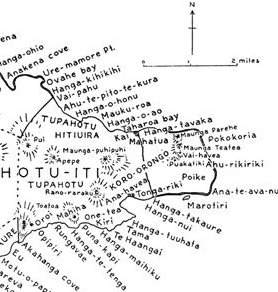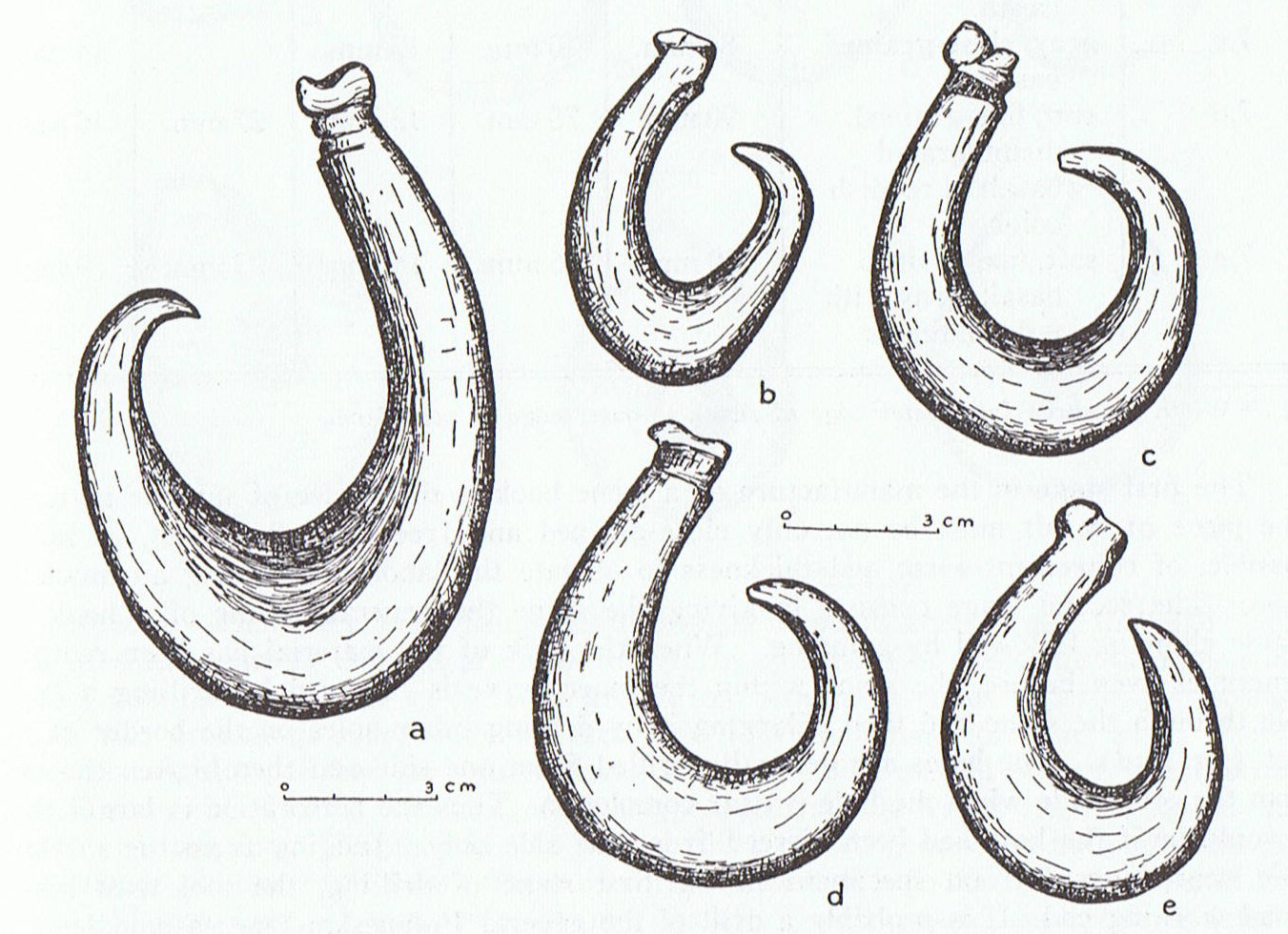1. If we regard Hanga Takaure as station
number14, then Hanga Hoonu will be number 20:
|
Around
Rano Kau: |
|
Old Land |
Te Pu Mahore |
Te Poko Uri |
|
Sea |
|
New land |
Te Manavai |
Te
Kioe Uri |
|
Along the southern coast - 1st part: |
|
5 Te Piringa Aniva |
6 Te Pei |
7 Te Pou |
|
Along the southern coast - 2nd part: |
|
8 Hua Reva |
9 Akahanga |
10 Hatinga
Te Kohe |

|
The eastern corner -
1st part: |
|
11
Roto Iri Are |
12 Tama (*) |
13 One Tea (†) |
|
The eastern corner
- 2nd part: |
|
14 Hanga Takaure |
15 Poike |
16 Pua Katiki |
|
The eastern corner
- 3rd part: |
|
17 Maunga Teatea |
18
Mahatua |
|
19 Taharoa |
20 Hanga Hoonu |
Bays (haga) are
evidently signs of 'joints' in time, where one 'limb' is joined to
the next. Hanga Takaure, the Bay of Flies, indicates a place
where the living spirits are accumulating, similar to how flies
were forming a cloud at Te Avaava Maea:
... When all had left,
when all the brothers were asleep, Tuu Maheke came and cut
off the head of Hotu A Matua. Then he covered
everything with soil. He hid (the head), took it, and went up. When
he was inland, he put (the head) down at Te Avaava Maea.
Another day dawned, and the men saw a dense swarm of flies pour
forth and spread out like a whirlwind (ure tiatia moana)
until it disappeared into the sky. Tuu Maheke understood ...
But the flies will return from the
sky when a person is born, and instead of cutting off a male old head,
to be buried in earth, it is female hair which will be cut off
to be wrapped around a very young person:
... I know I was born
at the edge of the sea, and you cut off a tuft of your hair and
wrapped me in it and threw me in the waves. After that the seaweed
took care of me and I drifted about in the sea, wrapped in long
tangles of kelp, until a breeze blew me on shore again, and some
jelly-fish rolled themself around me to protect me on the sandy
beach. Clouds of flies settled on me and I might have been eaten up
by the maggots; flocks of seabirds came, and I might have been
pecked to pieces. But then my great-ancestor Tama nui ki te rangi
arrived. He saw the clouds of flies and all the birds, and he
came and pulled away the jelly-fish, and there was I, a human being!
Well, he picked me up and washed me and took me home, and hung me in
the rafters in the warmth of the fire, and he saved my life ...
Hanga Takaure is where the
baby boy gets blown ashore again by the gentle breeze, and his place
of birth lies earlier, probably at Tama ('at the edge of the
sea'). The structure is similar to that of the Moon entrance at the
other end of the island:
| |
Birth of Sun (east) |
Birth of Moon (west) |
|
Old Land |
Tama (*) |
One Tea (†) |
Te Pu Mahore |
Te Poko Uri |
|
Sea |
|
New land |
Hanga Takaure |
Poike |
Te Manavai |
Te
Kioe Uri |
Apparently we can use
'geographical' myths from other parts of Polynesia in order to
better understand events on Easter Island.
The 8th kuhane
station is Hua Reva, presumably indicating where Moon is
uplifted (reva). The perfect number 8 is one more than the
number of days in a week, and from the table above we can conclude
it is Mercury, who is appearing both at Te Pu Mahore and at Poike.
He is both at the beginning and at the end. It must be so, because
'one more' will always be the same - the wheel of time returns.
The 8th island is Easter Island,
with Mercury both at its beginning (1) and end (15):
|
Not even
eight groups of people (i.e., countless boat crews) can
find the small piece (of land?) again once it has been
lost. But one can
take possession of the eighth land: (It
lies) 'on high', (it) juts out (on the horizon), and its
contours stand out against the (rising) sun (i.e., in
the east) ... |
evaru kaukau eko ravaa i
te pei ana
ka ngaro ro era etahi mo
ravaa he vau kainga i runga e tau e
revareva ro ta i roto i te
raa. |
The small piece of land is
where the little boy is washed ashore. The
rising sun is beginning there. Wordplay compares a single
revareva with a preceding pair of ravaa.
|
Reva
To hang down; flag, banner. Revareva,
1. To be hanging vertically; to detach oneself from the
background of the landscape, such a person standing on
top of a hill: ku-revareva-á te tagata i ruga i te
maúga. 2. To cast itself, to project itself (of
shadows); revareva-á te kohu o te miro i te maeha o
te mahina, the shadow of the tree casts itself in
the light of the moon. 3. Uvula.
To hang, to suspend, flag, banner;
hakareva, to hang up; hakarereva, to hang up,
to balance; hakarevareva, to wave. T Pau.:
reva, a flag; fakarevareva, to hang up, to
suspend. Mgv.: reva, a flag, a signal. Mq.:
éva, to hang up, to be suspended, to wave a signal.
Ta.: reva, a flag, banner; revareva, to
wave. The germ sense is that of being suspended ... any
light object hung up in the island air under the steady
tradewind will flutter; therefore the specification
involved in the wave sense is no more than normal
observation.
Mgv.: 1. A plant. Ta.: reva,
id. Mq.: eva, id. Sa.: leva, id. Ma.:
rewa-rewa, id. 2. To cross, to pass across quickly;
revaga, departure. Ta.: reva, to go away,
to depart. Ma.: reva, to get under way. Ta.: The
firmanent, atmosphere. Ha.: lewa, the upper
regions of the air, atmosphere, the visible heavens. |
|
Rava
1. Enough, sufficient;
ku-rava-á,
that's enough, it is sufficient. 2. To be satiated, to
be satisfied; ku rava-á
te tagata i te kai, the man has eaten his
fill. 3. Used very commonly before verbs to express
someone much inclined towards this action:
tagata rava taûa, quarrelsome person;
rava kai,
glutton; rava haúru,
sleepy-head; rava kî,
chatterbox; rava tagi,
cry-baby; rava keukeu,
hard-working; vara
is often used instead of
rava.
1. [I have missed to copy this page.]
2. To get, to have, to conquer, to gain, to obtain,
invasion, to capture, to procure, to recover, to
retrieve, to find, to bring back, to profit, to assist,
to participate, to prosper;
mea meitaki ka rava, to deserve. PS Pau.:
rave, to
take. Mgv.: rave,
to take, to acquire possession. Ta.:
rave, to
seize, to receive, to take. To.:
lava, to
achieve, to obtain. Viti:
rawā, to obtain, to accomplish ... 3. To know;
rava iu, to discern. 4. Large; hakarava,
to enlarge, to augment, to add. PS Sa.: lava,
large, very. 5. Hakarava, wide, width, across, to
put across, yard of a ship, firm; hakarava hakaturu,
quadrangular. P Mgv.: ravatua, the shelving ridge
of a road, poles in a thatch roof, a ridge. In the
Tongafiti speech this appears only in Maori whakarawa
to fasten with a latch of bolt ... 6. A prepositive
intensive; rava oho, to take root; rava keukeu,
to apply oneself; rava ahere, agile, without
fixed abode; rava ki, to prattle; rava vanaga,
to prate. Mq.: ava, enough, sufficient. 7.
Hakarava, gummy eyes, lippitude. 8. Hakarava
omua to come before, precede.
Ravagei,
to prattle. Ravahaga, capture. Ravaika, to
fish. Mgv.: raveika, a fisherman. Mq.: avaika,
avaiá, id. Ravakai (ravekai),
glutton, insatiable; tae ravekai, frugal.
Ravakata (ravakakata), jovial, merry.
Ravaki, to prattle, to tell stories, loquacious,
narrator, orator, eloquent, to boast, to speak evil, to
defame, slander, gossip. Ravapeto, to blab, to
speak evil. Ravapure, fervent, earnest.
Ravavae, invention. Ravatere, to scare away.
Neku ravatotouti, agile. Ravavanaga,
loquacious, garrulous, to tell stories, narration. Ta.:
raverave, a servant, to serve. Ha.: lawelawe,
to wait on the table, to serve. |
The pair of ravaa could
refer to the pair of 7 'nights' preceding the 15th station (Poike),
which indicates where Morning Sun stands out against the horizon
in the east (revareva). The 14 preceding stations are
like a
prelude, beginning with Te Pu Mahore (the little
quick and silvery fish Mercury).
Whatever ravaa means it
should allude to the capturing of fish (ravaika) I think:
... Dimly perceived is a connection between the
name Fakataka (Haka-taka) and the women who are
fishing in the reef pools (taka-taka), a circle (takataka)
of ten pairs (takau) having come together (taka)
to bring the fishes up.
|
Taka,
takataka.
Circle; to form circles, to gather, to get
together (of people).
1. A dredge. P Mgv.:
akataka,
to fish all day or all night with the line,
to throw the fishing line here and there.
This can only apply to some sort of net used
in fishing. We find in Samoa
ta'ā a
small fishing line, Tonga taka the
short line attached to fish hooks, Futuna
taka-taka a fishing party of women in
the reef pools (net), Maori takā the
thread by which the fishhook is fastened to
the line, Hawaii kaa in the same
sense, Marquesas takako a badly spun
thread, Mangareva takara a thread for
fastening the bait on the hook. 2. Ruddy. 3.
Wheel, arch; takataka, ball,
spherical, round, circle, oval, to roll in a
circle, wheel, circular piece of wood,
around; miro takataka, bush; haga
takataka, to disjoin; hakatakataka,
to round, to concentrate. P Pau.:
fakatakataka, to whirl around. Mq.:
taka, to gird. Ta.: taa, circular
piece which connects the frame of a house.
Takai, a curl, to tie; takaikai,
to lace up; takaitakai, to coil. P
Pau.: takai, a ball, to tie. Mgv.:
takai, a circle, ring, hoop, to go
around a thing. Mq.: takai, to voyage
around. Ta.: taai, to make into a
ball, to attach.
Takau,
Mgv.: ten pairs. Ta.: toau, id. Mq.:
tekau, id. To.: tekau, id.
Ma.: tekau, ten. |
Where a circle (takai)
is completed there must be an important joint in time, for
instance at Hanga Hoonu.
The glyph type haga rave maybe depicts a hook for
fishing, and the 'fish' captured is hardly an ordinary one but
instead land (in the sky):
 |
|
haga
rave |
Ravahaga = to
capture. Métraux has a picture of fishhooks with comments:

The pattern
of the stone hooks is uniform throughout, the principal
variations being in thickness at the bend and in the
distance between the point and the shank. Most of the
fishhooks have a continous curve, but in one specimen
(b) ... the limb from the bend to the point is almost
straight. The shank is topped by a knob or projecting
ridge with transverse grooves. A depression in the knob
divides it into two unequal parts - one rounded, and the
other small and sharp ... which is generally toward the
point. Below the ridge there is a recess, the inner
margin of which is sometimes serrated. The knob so
divided strongly resembles the outlines of birds' heads
as represented on the tablets
...
|


